The Glass Narratives | A feature on Chris Day by Catherine Rose for Mosaic & Glass Magazine
20th July 2023

The Glass Narratives | A feature on Chris Day by Catherine Rose for Mosaic & Glass - The Magazine for Mosaicists | June 2023
Mixed-race ceramicist and glass artist Christopher Day tells stories about the black experience and doesn’t shy away from hard-hitting subjects. His emotionally charged pieces have won global acclaim and are in collections at the V&A and the National Museum of Scotland, as well as having been exhibited in seven major museums. He has recently been artist in residence at The Museum of Glass in Tacoma, Washington. Catherine Rose talks to him about his rise as a glass artist.
Chris Day says there are four things he thanks for his meteoric rise as a glass artist over the past six years: dyslexia, his wife Melissa, Vessel Gallery and George Floyd.
He believes the art world was stagnant for black artists until the murder of Floyd. “It was a catalyst for change,” he says. “Things are improving but we are still treading the muddy waters of racial discrimination.”
Growing up on a council estate in Derby, Chris struggled at school but, living with “the gift” of dyslexia, he excelled creatively and practically. He went into a career in plumbing. Copper was later to become one of the bedrocks of his glass practice.
His life as an artist began in 2016 when, at 48 years old, he was persuaded by Melissa to undertake a degree course in Applied Glass and Ceramics at the University of Wolverhampton. After graduating, he spent a year in residency and last year completed his master’s degree. He has juggled his studies and practice with continued work as a plumbing and heating engineer, which helps cover the high costs of hot shop work.
When Chris began his course, he could find no other black glass artists. Instead, he discovered work by individual members of Wolverhampton’s BLK – a 1970s black art movement that covered controversial subjects centred around racial prejudice. Although frequently censored for being socially unacceptable, Chris describes their work as “art that subverted fear”. Later, he came across conceptual artist and activist Fred Wilson’s 2001 glass sculpture Drip, Drop, Plop that challenges white caricaturising of black people. He was hooked.
Chris spent hours researching black history. Much of his research was image based, which he found he responded to on a deeply emotional and psychological level, later revealing itself almost subconsciously in his work, particularly in his use of colour.
It was while undertaking an exploratory work at university in 2019 that Chris uncovered the method that became his signature. He was experimenting with blowing glass into copper cages, from 15mm strips down to 2mm wire, to see what the copper would do to the glass in the cooling process.
![]()
Chris Day's unique method of making involving his signature copper cages. Photos by Tom Arber
“The glass bases were round and because I was doing so many, I needed to hang them up. As soon as I did that, it all came together,” says Chris. By constricting glass using copper, Chris realised he could bring to life the subjects he was passionate about, like slavery and civil rights, and tell these stories through his art.
![]()
Strange Fruit installation by Chris Day on show at Harewood House. Photo by Tom Arber
It was a lightbulb moment. The pieces became the work Strange Fruit – a homage to Billie Holliday’s mournful song of the same name, based on a 1937 poem about the lynching of black people in America’s Deep South. “The concept of Strange Fruit isn’t just confined to America. We’re just not necessarily hanging people from trees,” he says, referring directly to the 1993 killing of Stephen Lawrence.
He was the first student at Wolverhampton University in a decade to earn a place in the British Glass Biennale in Stourbridge with Strange Fruit in 2019, where the installation was first shown in full. It resulted in his representation by Angel Monzon at London’s Vessel Gallery.
Chris considers his most significant work to be Emmett Till, which refers to the heart wrenching case of the 14-year-old who was kidnapped from his home, tortured and brutally murdered by a Mississippi white gang in 1955 who were subsequently acquitted.
The story has recently been released as a film focusing on Emett’s mother Mamie, who became a black rights activist after her son’s death. “I felt guilty when I learned Emett’s story as I’d never heard it. It wasn’t taught at school,” says Chris who feels that, despite Black History Month, there is still a woeful lack of education about these emotionally raw subjects.
He spent a weekend looking at harrowing images on the internet and from it produced a ceramic bowl with jagged glass, splattered in red paint. It was a symbolic vessel to catch the tears of “mothers, fathers, brothers and sisters who have experienced brutality because of the colour of their skin”. While trying to explain it to his tutor, he broke down.
“I realised then I had to step up like Mamie Till,” he says. “That piece was emotionally integral to telling the stories that people don’t necessarily know about.” The final piece was a mixed-media sculpture that looks like a broken heart, fashioned from terracotta, tree trunk, glass and copper wire. Emmett Till now resides in the V&A’s permanent collections although it is not currently on display.
![]()
Emmett Till by Chris Day. Photo by Ester Segarra
Chris has had to dig deep to unearth black histories. He was dismayed to discover there is very little platform for Transatlantic slavery artefacts at the British Museum, for example. “You’d expect places of learning to be more diverse but they’re not,” he says. “At university, I was bringing black artists to the attention of my lecturers.”
Similarly, he was disappointed by Liverpool Slavery Museum where he felt displays largely lacked human emotion and experience. He has tried to introduce that missing element into his work. “I don’t want people to view my work in a cabinet and then walk away. I want tears to flow. As soon as you’ve made people react, you’ve made your point,” adds Chris.
Commodity Triptych, completed in 2019, features black glass heads crammed into three wooden crates marked “Property of British Sugar”. And from sculptures such as The Congregation, to Message in a Bottle, stories around the Transatlantic slave trade permeate Chris’s work.
In 2021, he was asked to participate in an exhibition on colonial history at Harewood House, Yorkshire by Hannah Obee, director of collections, programme and learning.
Situated in All Saints Church, in the house grounds, Chris needed to conceive artwork on a grand scale in order to own the space. “When I heard they’d discovered 28 bottles of 18th century rum at the house, made using sugar harvested by black slaves in the Caribbean, I knew that was what I wanted to portray,” he says.
Chris made bottles in colours based on Turner’s painting The Slave Ship, which is believed to illustrate the story of the Transatlantic slave ship Zong whose captain Luke Hollingwood gave orders to throw 130 of his African slaves overboard in 1781, subsequently claiming financial compensation for them. Chris’s work, entitled Under the Influence, is therefore not only symbolic of the 28 bottles, but of the enslaved people themselves.
![]()
Chris Day with his work Under the Influence at Harewood House. Photo by Charlotte Graham
He had been struggling to give the bottles the humanity they needed until one day he saw a black student with braided hair wound into a bun and had the clever idea of using coiled black rope to make the bottle tops. Beneath them, the glass bulges like shackled skin. Under the Influence was also displayed at the 2022 British Glass Biennale.
One of Chris’s largest artworks, After the Darkness, the Light, is shaped like a boat and addresses the controversial subject of migration. Its concept originally came from Chris’s research into the Huguenots but went on to represent the plight of all migrants and to question why we are happy to let in certain migrants but not others.
Nevertheless, he doesn’t consider himself a political artist. “The storytelling is the most important thing for me,” he explains. “People will be enticed by the colours and strangeness of the piece and then a conversation can start.” There were many of those conversations at Tacoma where Chris was recently invited on a residency – an experience he found profoundly cathartic.
“It was phenomenal. I was giving glass blowing demonstrations, making six pieces a day, some of the biggest I’ve ever produced – up to three feet high.” Five of those pieces have been kept by the Museum of Glass for their forthcoming exhibition Two Way Mirror.
“I also gave talks about my heritage,” he adds. “People were responding with their own experiences. Some were in tears. It was such a supportive environment. Art can give you a comfort zone to open up."
"As soon as you’re up on that platform, you’ve got a responsibility. I’ve had low self-worth and felt the stigma of being mixed race all my life, but I’ve suppressed it. Through my artwork, I want to give the opportunity to people like me to let all of that out. If you can change how someone feels, you’re making a difference.”
His most recent work Colour Blind, at SoShiro’s Not Black or White exhibition, is about that experience.
![]()
Colour Blind series by Chris Day. Courtesy of Vessel Gallery. Photo by Agata Pec
Chris is travelling to Detroit in September for the GAS Conference where he will be demonstrating, and there is a return to Tacoma planned for Two Way Mirror in October.
He admires Tacoma’s community-based approach and their nurturing of young artists from underprivileged backgrounds through projects, such as Hilltop Glass Artists, where youngsters who would otherwise never be able to afford it, can experience working in a hot shop. He worries that the industry in the UK isn’t doing enough to support and encourage underprivileged and black communities, with a lack of conspicuous role models for young black artists.
“How can we interact with ethnic communities if they don’t even know where the door is, let alone how to open it?” he says.
An unassuming man, he remains astonished at how his life has changed over the past six years.
But despite the many challenges, he remains committed to glass and the stories that are too important not to be told. As Martin Luther King said: “Our lives begin to end the day we remain silent about things that matter”.
![]()
Chris Day with his artwork After the Darkness, the Light. Photo by Simon Bruntnell
Further artworks by Chris Day
With thanks to Mosaic & Glass magazine
Photography by Agata Pec, Charlotte Graham, Tom Arber and Simon Bruntnell
Mixed-race ceramicist and glass artist Christopher Day tells stories about the black experience and doesn’t shy away from hard-hitting subjects. His emotionally charged pieces have won global acclaim and are in collections at the V&A and the National Museum of Scotland, as well as having been exhibited in seven major museums. He has recently been artist in residence at The Museum of Glass in Tacoma, Washington. Catherine Rose talks to him about his rise as a glass artist.
Chris Day says there are four things he thanks for his meteoric rise as a glass artist over the past six years: dyslexia, his wife Melissa, Vessel Gallery and George Floyd.
He believes the art world was stagnant for black artists until the murder of Floyd. “It was a catalyst for change,” he says. “Things are improving but we are still treading the muddy waters of racial discrimination.”
Growing up on a council estate in Derby, Chris struggled at school but, living with “the gift” of dyslexia, he excelled creatively and practically. He went into a career in plumbing. Copper was later to become one of the bedrocks of his glass practice.
His life as an artist began in 2016 when, at 48 years old, he was persuaded by Melissa to undertake a degree course in Applied Glass and Ceramics at the University of Wolverhampton. After graduating, he spent a year in residency and last year completed his master’s degree. He has juggled his studies and practice with continued work as a plumbing and heating engineer, which helps cover the high costs of hot shop work.
When Chris began his course, he could find no other black glass artists. Instead, he discovered work by individual members of Wolverhampton’s BLK – a 1970s black art movement that covered controversial subjects centred around racial prejudice. Although frequently censored for being socially unacceptable, Chris describes their work as “art that subverted fear”. Later, he came across conceptual artist and activist Fred Wilson’s 2001 glass sculpture Drip, Drop, Plop that challenges white caricaturising of black people. He was hooked.
Chris spent hours researching black history. Much of his research was image based, which he found he responded to on a deeply emotional and psychological level, later revealing itself almost subconsciously in his work, particularly in his use of colour.
It was while undertaking an exploratory work at university in 2019 that Chris uncovered the method that became his signature. He was experimenting with blowing glass into copper cages, from 15mm strips down to 2mm wire, to see what the copper would do to the glass in the cooling process.
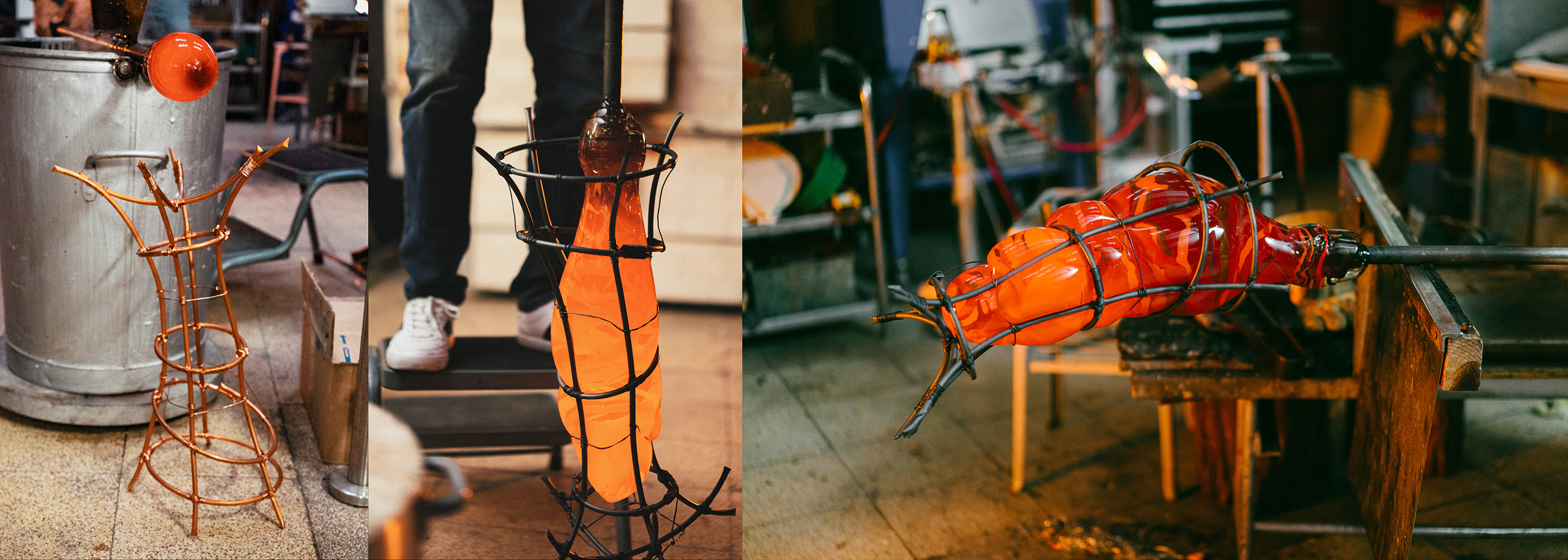
Chris Day's unique method of making involving his signature copper cages. Photos by Tom Arber
“The glass bases were round and because I was doing so many, I needed to hang them up. As soon as I did that, it all came together,” says Chris. By constricting glass using copper, Chris realised he could bring to life the subjects he was passionate about, like slavery and civil rights, and tell these stories through his art.
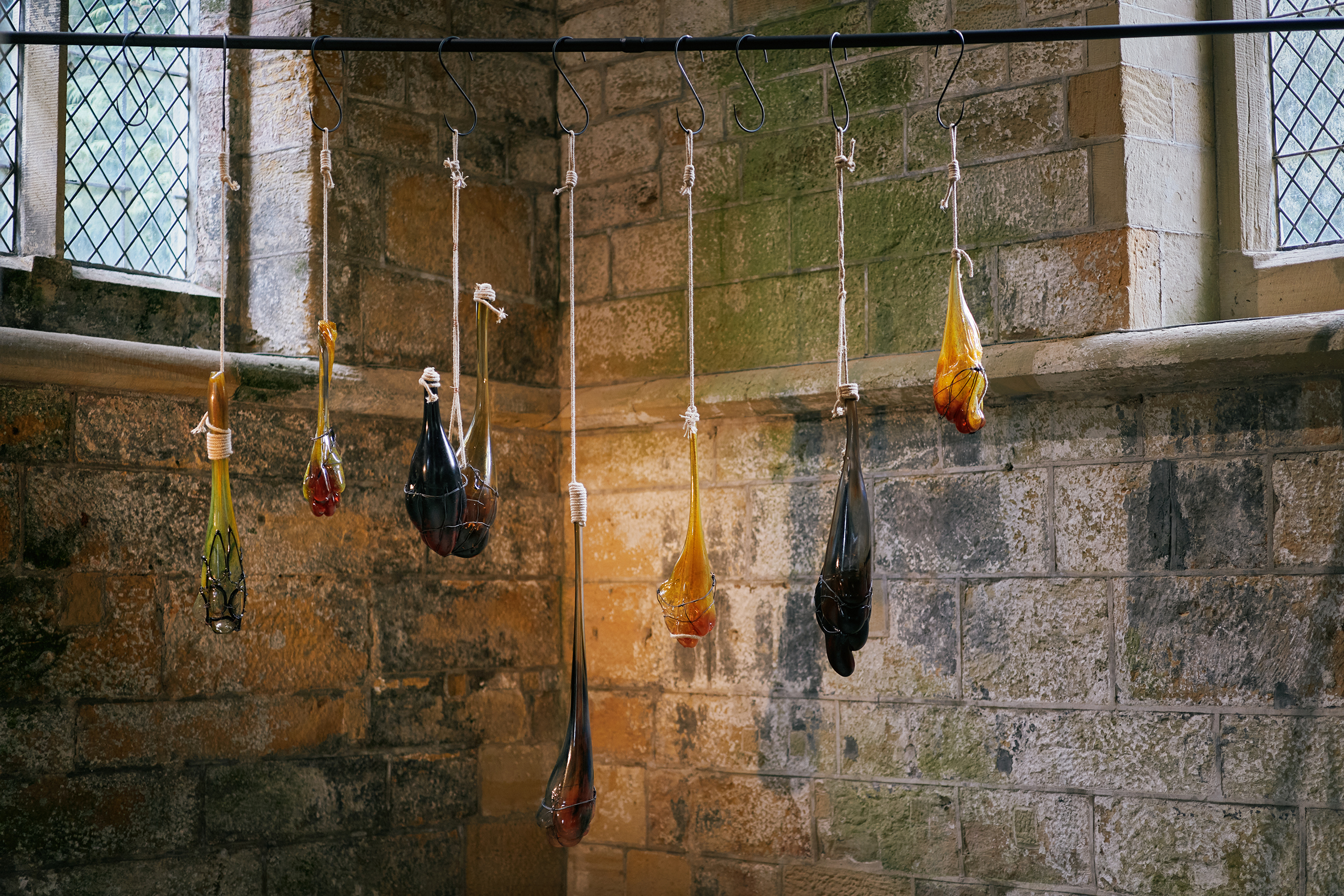
Strange Fruit installation by Chris Day on show at Harewood House. Photo by Tom Arber
It was a lightbulb moment. The pieces became the work Strange Fruit – a homage to Billie Holliday’s mournful song of the same name, based on a 1937 poem about the lynching of black people in America’s Deep South. “The concept of Strange Fruit isn’t just confined to America. We’re just not necessarily hanging people from trees,” he says, referring directly to the 1993 killing of Stephen Lawrence.
He was the first student at Wolverhampton University in a decade to earn a place in the British Glass Biennale in Stourbridge with Strange Fruit in 2019, where the installation was first shown in full. It resulted in his representation by Angel Monzon at London’s Vessel Gallery.
Chris considers his most significant work to be Emmett Till, which refers to the heart wrenching case of the 14-year-old who was kidnapped from his home, tortured and brutally murdered by a Mississippi white gang in 1955 who were subsequently acquitted.
The story has recently been released as a film focusing on Emett’s mother Mamie, who became a black rights activist after her son’s death. “I felt guilty when I learned Emett’s story as I’d never heard it. It wasn’t taught at school,” says Chris who feels that, despite Black History Month, there is still a woeful lack of education about these emotionally raw subjects.
He spent a weekend looking at harrowing images on the internet and from it produced a ceramic bowl with jagged glass, splattered in red paint. It was a symbolic vessel to catch the tears of “mothers, fathers, brothers and sisters who have experienced brutality because of the colour of their skin”. While trying to explain it to his tutor, he broke down.
“I realised then I had to step up like Mamie Till,” he says. “That piece was emotionally integral to telling the stories that people don’t necessarily know about.” The final piece was a mixed-media sculpture that looks like a broken heart, fashioned from terracotta, tree trunk, glass and copper wire. Emmett Till now resides in the V&A’s permanent collections although it is not currently on display.
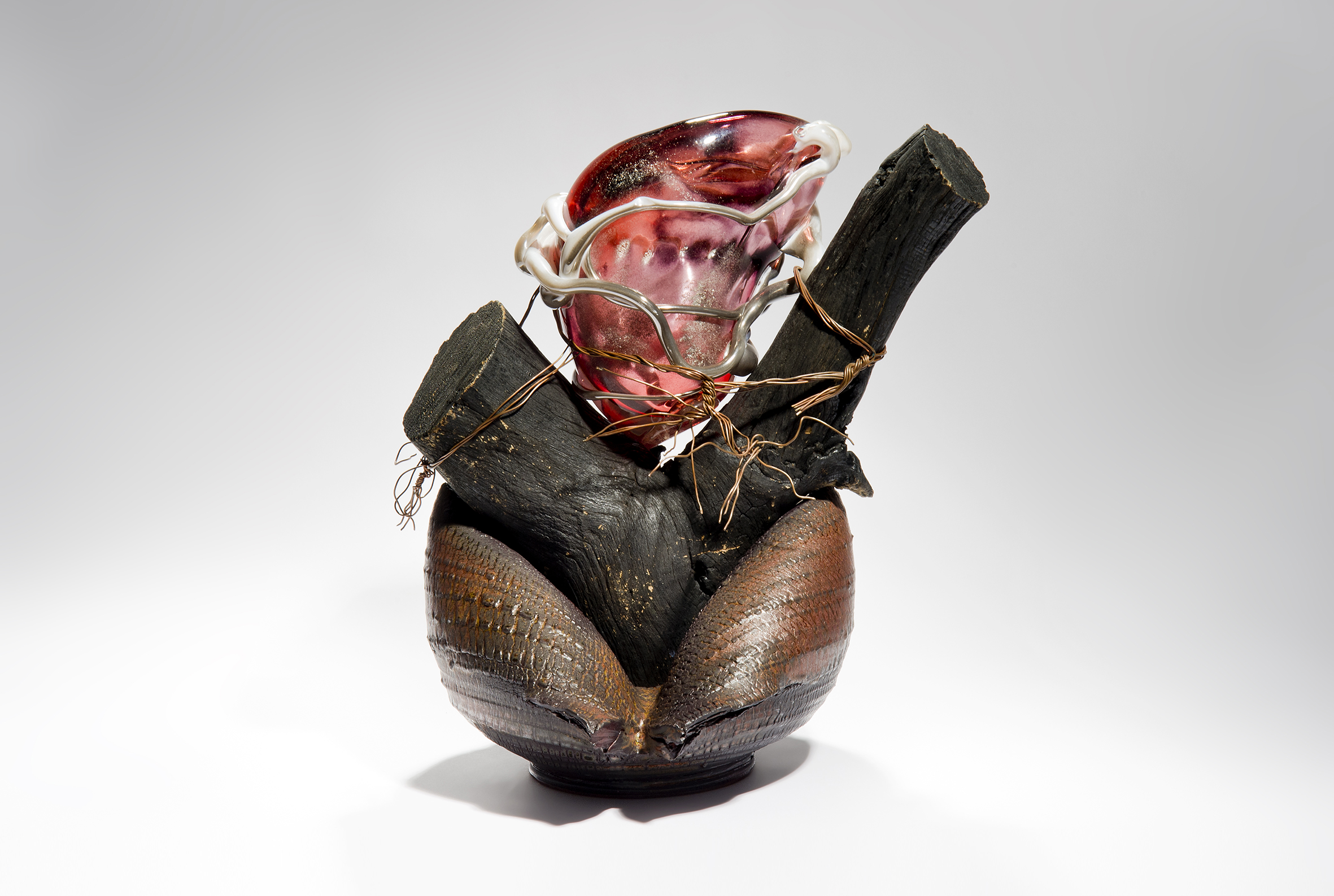
Emmett Till by Chris Day. Photo by Ester Segarra
Chris has had to dig deep to unearth black histories. He was dismayed to discover there is very little platform for Transatlantic slavery artefacts at the British Museum, for example. “You’d expect places of learning to be more diverse but they’re not,” he says. “At university, I was bringing black artists to the attention of my lecturers.”
Similarly, he was disappointed by Liverpool Slavery Museum where he felt displays largely lacked human emotion and experience. He has tried to introduce that missing element into his work. “I don’t want people to view my work in a cabinet and then walk away. I want tears to flow. As soon as you’ve made people react, you’ve made your point,” adds Chris.
Commodity Triptych, completed in 2019, features black glass heads crammed into three wooden crates marked “Property of British Sugar”. And from sculptures such as The Congregation, to Message in a Bottle, stories around the Transatlantic slave trade permeate Chris’s work.
In 2021, he was asked to participate in an exhibition on colonial history at Harewood House, Yorkshire by Hannah Obee, director of collections, programme and learning.
Situated in All Saints Church, in the house grounds, Chris needed to conceive artwork on a grand scale in order to own the space. “When I heard they’d discovered 28 bottles of 18th century rum at the house, made using sugar harvested by black slaves in the Caribbean, I knew that was what I wanted to portray,” he says.
Chris made bottles in colours based on Turner’s painting The Slave Ship, which is believed to illustrate the story of the Transatlantic slave ship Zong whose captain Luke Hollingwood gave orders to throw 130 of his African slaves overboard in 1781, subsequently claiming financial compensation for them. Chris’s work, entitled Under the Influence, is therefore not only symbolic of the 28 bottles, but of the enslaved people themselves.
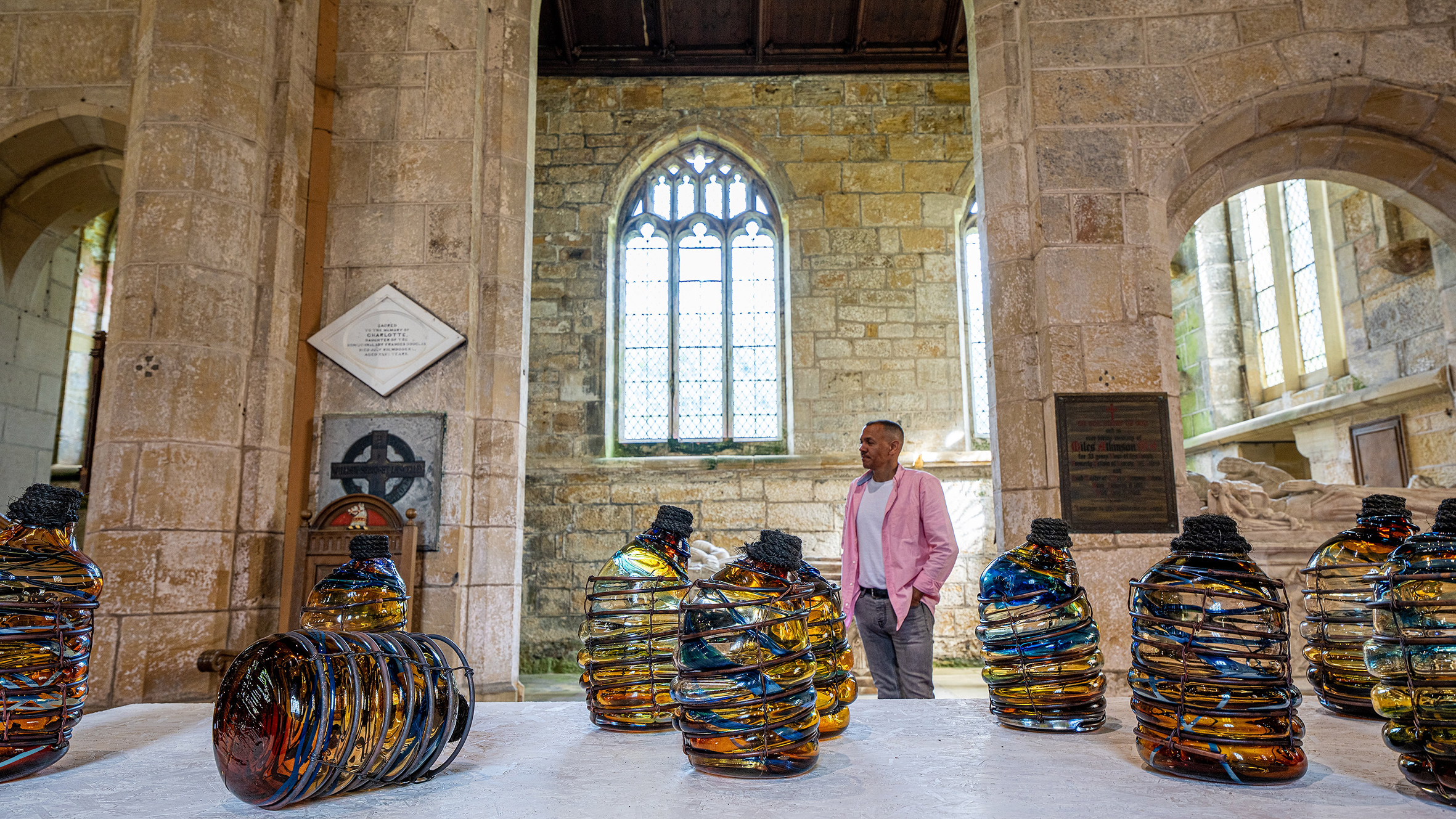
Chris Day with his work Under the Influence at Harewood House. Photo by Charlotte Graham
He had been struggling to give the bottles the humanity they needed until one day he saw a black student with braided hair wound into a bun and had the clever idea of using coiled black rope to make the bottle tops. Beneath them, the glass bulges like shackled skin. Under the Influence was also displayed at the 2022 British Glass Biennale.
One of Chris’s largest artworks, After the Darkness, the Light, is shaped like a boat and addresses the controversial subject of migration. Its concept originally came from Chris’s research into the Huguenots but went on to represent the plight of all migrants and to question why we are happy to let in certain migrants but not others.
Nevertheless, he doesn’t consider himself a political artist. “The storytelling is the most important thing for me,” he explains. “People will be enticed by the colours and strangeness of the piece and then a conversation can start.” There were many of those conversations at Tacoma where Chris was recently invited on a residency – an experience he found profoundly cathartic.
“It was phenomenal. I was giving glass blowing demonstrations, making six pieces a day, some of the biggest I’ve ever produced – up to three feet high.” Five of those pieces have been kept by the Museum of Glass for their forthcoming exhibition Two Way Mirror.
“I also gave talks about my heritage,” he adds. “People were responding with their own experiences. Some were in tears. It was such a supportive environment. Art can give you a comfort zone to open up."
"As soon as you’re up on that platform, you’ve got a responsibility. I’ve had low self-worth and felt the stigma of being mixed race all my life, but I’ve suppressed it. Through my artwork, I want to give the opportunity to people like me to let all of that out. If you can change how someone feels, you’re making a difference.”
His most recent work Colour Blind, at SoShiro’s Not Black or White exhibition, is about that experience.
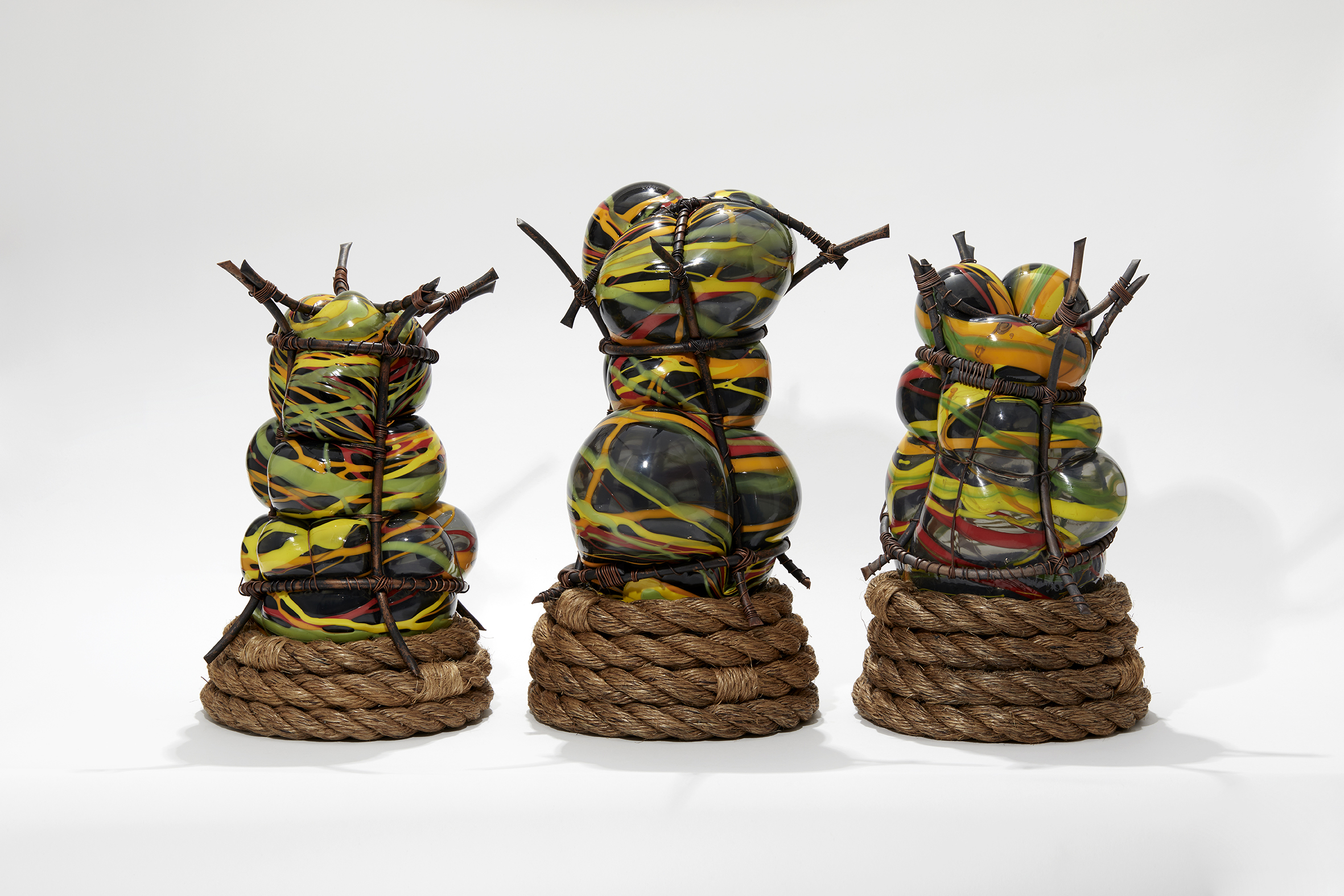
Colour Blind series by Chris Day. Courtesy of Vessel Gallery. Photo by Agata Pec
Chris is travelling to Detroit in September for the GAS Conference where he will be demonstrating, and there is a return to Tacoma planned for Two Way Mirror in October.
He admires Tacoma’s community-based approach and their nurturing of young artists from underprivileged backgrounds through projects, such as Hilltop Glass Artists, where youngsters who would otherwise never be able to afford it, can experience working in a hot shop. He worries that the industry in the UK isn’t doing enough to support and encourage underprivileged and black communities, with a lack of conspicuous role models for young black artists.
“How can we interact with ethnic communities if they don’t even know where the door is, let alone how to open it?” he says.
An unassuming man, he remains astonished at how his life has changed over the past six years.
But despite the many challenges, he remains committed to glass and the stories that are too important not to be told. As Martin Luther King said: “Our lives begin to end the day we remain silent about things that matter”.
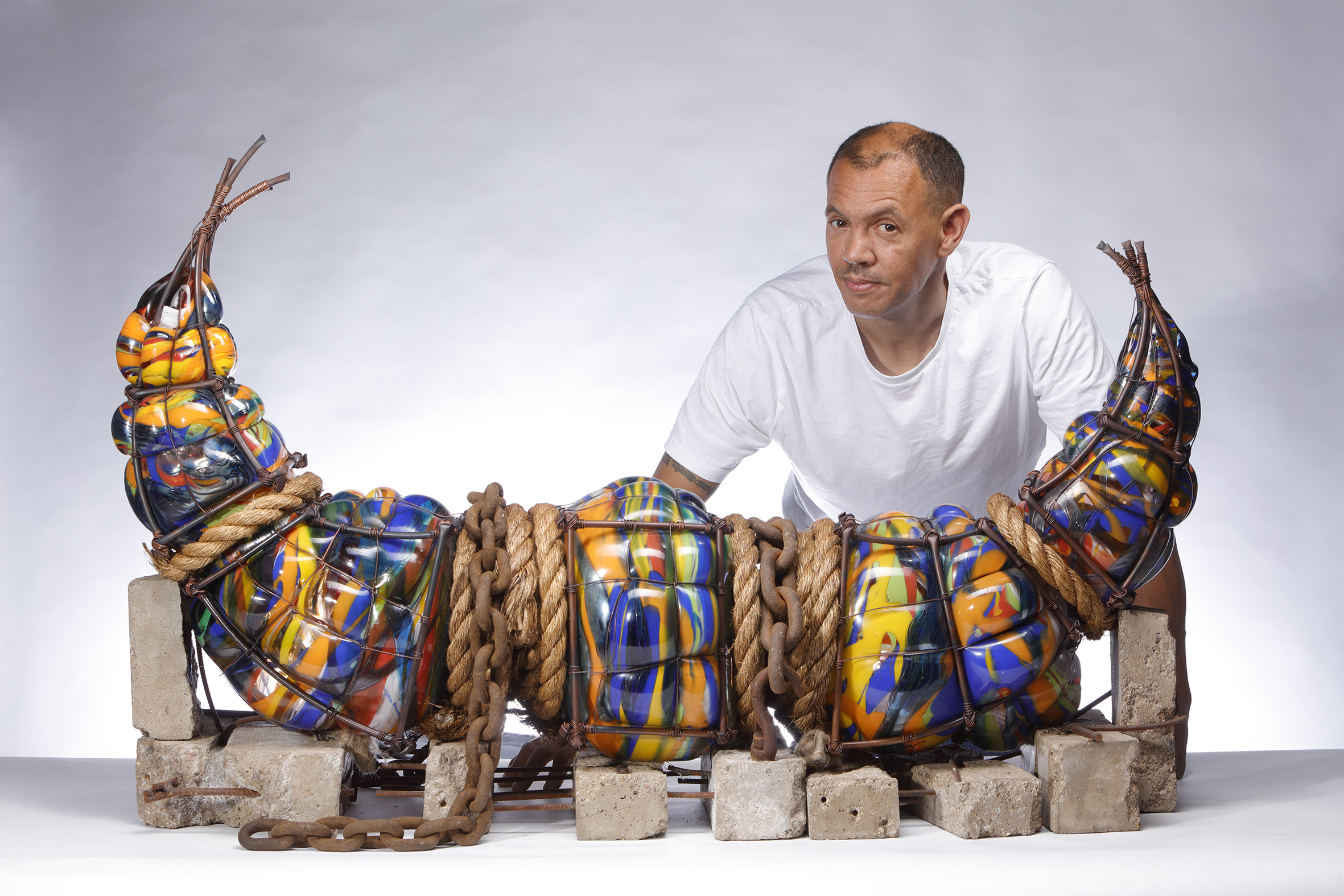
Chris Day with his artwork After the Darkness, the Light. Photo by Simon Bruntnell
Further artworks by Chris Day
With thanks to Mosaic & Glass magazine
Photography by Agata Pec, Charlotte Graham, Tom Arber and Simon Bruntnell

